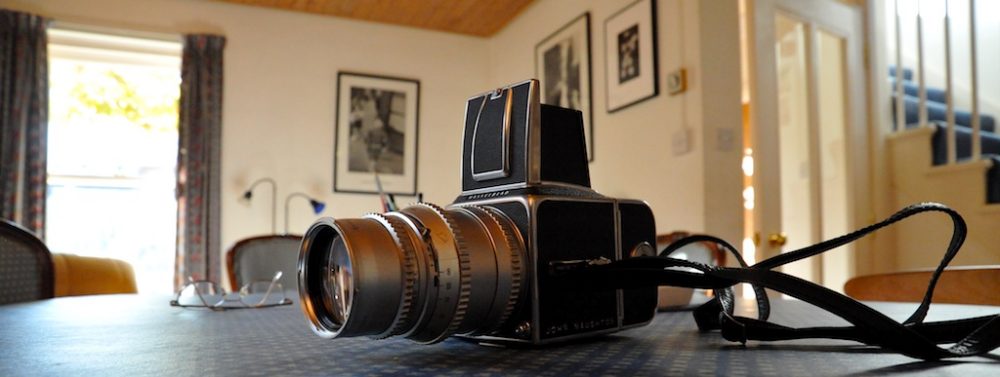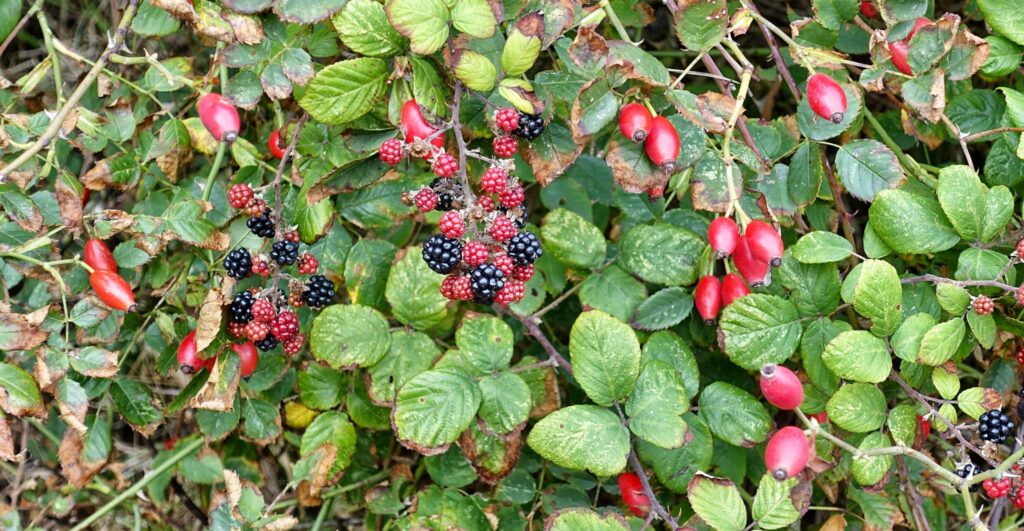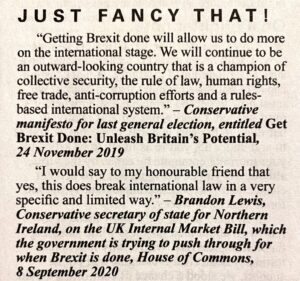Mellow fruitfulness
Rose-hips and blackberries. Seen on our coastal walk yesterday.
Quote of the Day
”The best number for a dinner party is two — myself and a damn good head waiter.”
- Nubar Gulbenkian
I have a good friend who used to say that the best conversations in his house always took place between himself and the TV set.
Musical alternative to the radio news of the day
Für Elise: Lang Lang
A year is such a long time in Brexit politics
Private Eye, 25 September, 2020
Tracking historical changes in trustworthiness using machine learning analyses of facial cues in paintings
It’s amazing what people do research on. This paper published in Nature Communications describes an interesting use of machine-learning technology to analyse portraits over the ages. The researchers built an algorithm to automatically generate trustworthiness evaluations for the facial action units (smile, eye brows, etc.) of European portraits in large historical databases. Their results show that “trustworthiness in portraits increased over the period 1500–2000 paralleling the decline of interpersonal violence and the rise of democratic values observed in Western Europe.
Portraits are particularly promising to document and quantify the level of trust over time. Experimental work have revealed that specific facial features, such as a smiling mouth or wider eyes, are consistently recognized as cues of trustworthiness across individuals and cultures. In this paper, we capitalize on this large empirical literature to build an algorithm that estimates trustworthiness based on a pre-identified set of facial characteristics. More precisely, we apply recent machine-learning methods to extract quantitative information about the evolution of social cues contained in portraits. The algorithm generates automatic human-like trustworthiness ratings on portraits based on the muscle contractions (facial action units) detected in facial displays using the open software OpenFace. This algorithm was trained on avatars controlled for trustworthiness and optimized using a random forest procedure (see Supplementary Methods for more details). To assess the generalizability of our model, we then tested its validity on four databases of natural faces rated by real participants. We first demonstrated that the algorithm produced trustworthiness ratings that were aligned with those produced by human participants in all four controlled databases.
Interestingly, the only painting illustrated in the paper — a portrait of Thomas Cranmer, who was Archbishop of Canterbury during the reigns of Henry VIII, Edward VI and, for a short time, Mary I. He helped build the case for the annulment of Henry’s marriage to Catherine of Aragon, which was one of the causes of the separation of the English Church from union with the Holy See. Along with Thomas Cromwell, he supported the principle of royal supremacy. So he was the polar opposite of a “troublesome priest”. Interestingly, the algorithm examined Gerlach Flicke’s famous portrait of Cranmer and pronounced him untrustworthy. Which I’d say was a pretty shrewd assessment.
Jonathan Dancy’s British Academy memoir of Derek Parfit.
Whenever a Fellow of the British Academy dies, the Academy commissions another Fellow to write an extended memoir of him. (The Royal Society has a similar tradition.) Jonathan Dancy’s memoir of the Oxford Philosopher Derek Parfit is a gem. (And quite a long read.)
Parfit was a genius, but by the metric-driven standards of contemporary academia he would have had difficulty holding onto an academic post. I never knew him personally, but his wife, Janet Radcliffe Richards, was at one time a valued colleague of mine, and it was from her that I learned that in addition to being a distinguished philosopher he was also an interesting and fastidious photographer. Larissa MacFarquhar wrote a fabulous New Yorker profile of him in 2011. Here she is on his photographic habit:
Sometime after he gave up the idea of being a poet, Parfit developed a new aesthetic obsession: photography. He drifted into it—a rich uncle gave him an expensive camera—but later it occurred to him that his interest in committing to paper images of things he had seen might stem from his inability to hold those images in his mind. He also believed that most of the world looked better in reproduction than it did in life. There were only about ten things in the world he wanted to photograph, however, and they were all buildings: the best buildings in Venice—Palladio’s two churches, the Doge’s Palace, the buildings along the Grand Canal—and the best buildings in St. Petersburg, the Winter Palace and the General Staff Building.
His photographs are enigmatic and fascinating. Bryan Appleyard (himself a photographer) has a lovely New Statesman piece about an exhibition of them held in 2018.
His perfectionism in photography was as fierce as in his philosophy. Over about 25 years he shot thousands of rolls of film but he only believed he had made “about 120 good photographs”. There was method in this, an adaptation of his own sense of a shortcoming. “What he said about the whole project,” says Richards, “was that he wasn’t an artist but he was a good critic, so he took thousands and thousands of photographs and just selected the ones he thought were best.”
Sometimes his processing went wrong. Richards tells me that one St Petersburg picture was not displayed by the gallery because it was just too processed – “too CGI, too postcard”. And his favoured cities did not always co-operate. He eventually stopped going to St Petersburg because he said the snow had become the wrong colour and he abandoned photography altogether when he decided weather in general had changed.
From a distance Parfit struck me as an astonishing combination of formidable intellect and a kind of childlike innocence; and also as a thoroughly good person. Dancy’s memoir and MacFarquahar’s profile reinforce that impression.
This blog is also available as a daily email. If you think this might suit you better, why not subscribe? One email a day, delivered to your inbox at 7am UK time. It’s free, and there’s a one-click unsubscribe if you decide that your inbox is full enough already!


